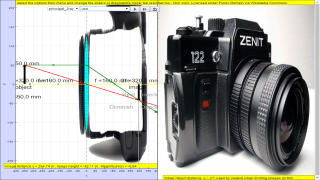About
Topics
LightRefraction of light
Thin lenses
Description Thin Len Converging Ray Simulation
The Thin lens equation assumed that if the distances from the object to the lens and from the lens to the image are u and v respectively, for a lens of negligible thickness, in air, the distances are related by the thin lens formula:
1/u + 1/v = 1/f
What this means is that, if an object is placed at a distance u along the axis in front of a positive lens of focal length f, a screen placed at a distance v behind the lens will have a sharp image of the object projected onto it.
When Object distance, u is near infinity ( very big compared to f), the lens is used by telescopes. note that Convex (converging) lenses produce an image of an object at infinity at their focus.if the sun is imaged, much of the visible and infrared light incident on the lens is concentrated into the small image. A large lens will create enough intensity to burn a flammable object at the focal point
- When Object distance, u > 2*f, the lens is used by camera when forming images on film and the eyes.
- When Object distance, u = 2*f, the lens is used by photocopier when making equal size copies.
- When Object distance, f < u < 2*f, the lens is used by overhead projector to form magnified image.
- When Object distance, u = f, the lens is used by spotlight when projecting parallel beam of light.
- When Object distance, u < f, the lens is used by magnifying glass when viewing a enlarged image.
where M is the magnification factor; if |M|>1, the image is larger than the object. Notice the sign convention here shows that, if M is negative, as it is for real images, the image is upside-down with respect to the object. For virtual images, M is positive and the image is upright.
Please note that the shape of the lens adjust with the focal length is for illustration purposes, it is not scientific.
This thin lens ray diagram java applet has:
Main view:
Lens that is controllable by the focal length f, +f imply converging lens -f imply diverging lens.Focal points drag-able, 2F, F, F & 2F
u is position of Object from lens center c
v is position of Image from lens center c.
The object is drag-able to the right side of the lens
Top View:
dynamically display a possible use of the lens under different conditions with pictures shared under creative commons licenses and other similar pro usage licenses under attribution.Bottom View:
4 radio buttons: allows for different visualization purposes of light path in the context of lens- no ray
- principal-ray
- marginal ray
- all ray
4 check boxes:
- "Real/Virtual?"
- "Inverted/Upright?"
- "Magnify/Diminish?"
- "Same/Opposite side"
3 slider control:
- u, object distance from c
- h, height of object f,
- focal length of lens
3 values display:
- v,image distance from c
- ih, image height
- M, Magnification
Activity:
Explore the simulation. Notice that you can move the sliders to vary the distance of the object to the center of the thin lens. What do each of the sliders, radio buttons and check-boxes do?Take about 10 minutes to inquiry through the simulation model and describe the action of a thin converging lens on a beam of light. ( this simulation currently does not have beam of light)
Discuss with your lab partner what is the meaning of the focal length f.
hint: in terms of the way the light rays from the object is bend and pass through where?
check the principal rays radio button. Discuss and formulate ideas how the ray diagram allows the drawing of ray diagrams to illustrate the formation of real and virtual images of an object by a
thin converging lens.
- What does the green ray light always do?
- What does the red ray light always do?
- What does the teal ray light always do?
What does the term linear magnification mean in this simulation.
Discuss how it is calculated from?
How many ways are there to determine the magnification of the think converging lens.
Check the no ray radio button. move the sliders a suitable position of your choice. Now, sketch as accurately as possible on a piece of paper, the principal ray diagram ( minimum 2 rays) to get the image position and height. Practice a few times with different and varied examples to allow you to draw scale diagrams to deduce the focal length needed for particular values of magnification (converging lens only)
explore the simulation to make observations of the use of a single converging lens as a
- magnifying glass
- a projector
Suggested answers:
By definition, focal length is the distance between the point in the lens where the light begins to diverge (the nodal point) when the object is set at infinity.Magnification M = - v/u = ih/h
Sample Learning Goals
(h) describe the action of a thin lens (both converging and diverging)
on a beam of light
(i) define the term focal length for a converging lens
(j) draw ray diagrams to illustrate the formation of real and virtual images of an object by a thin converging lens
(i) define the term focal length for a converging lens
(j) draw ray diagrams to illustrate the formation of real and virtual images of an object by a thin converging lens
Version:
Translations
| Code | Language | Translator | Run | |
|---|---|---|---|---|
 |
||||
Software Requirements
| Android | iOS | Windows | MacOS | |
| with best with | Chrome | Chrome | Chrome | Chrome |
| support full-screen? | Yes. Chrome/Opera No. Firefox/ Samsung Internet | Not yet | Yes | Yes |
| cannot work on | some mobile browser that don't understand JavaScript such as..... | cannot work on Internet Explorer 9 and below |
Credits

 Fu-Kwun Hwang; lookang (This email address is being protected from spambots. You need JavaScript enabled to view it.)
Fu-Kwun Hwang; lookang (This email address is being protected from spambots. You need JavaScript enabled to view it.)
Google Play Store Apps
https://play.google.com/store/apps/details?id=com.ionicframework.lensapp223196#details-reviews
https://itunes.apple.com/us/app/lens-converging-diverging/id1164800839?mt=8
ICT connection lesson
- http://library.opal.moe.edu.sg/ictc&func=view&rid=2047 by Joseph Chua
Learning Outcomes
- Describe (to tell or depict) how light behaves when it passes through a thin converging or diverging lens.
- Define (to state the meaning) the term focal length for a thin converging lens.
- Draw (to sketch accurately) ray diagrams to illustrate how real and virtual images are formed by a thin converging lens.
Video
Ejs open source converging & diverging Lens object image high school java applet by Loo Kang Wee
ICT connection lessons
- http://library.opal.moe.edu.sg/ictc&func=view&rid=2047 by Joseph Chua
Version:
- http://weelookang.blogspot.sg/2015/05/ejss-thin-converging-diverging-lens-ray.html Blog Post JavaScript version by Fu-Kwun Hwang and Loo Kang Wee
- http://www.phy.ntnu.edu.tw/ntnujava/index.php?topic=1155.0 Ejs open source converging & diverging Lens object image high school java applet by Fu-Kwun Hwang and Loo Kang Wee
- http://www.phy.ntnu.edu.tw/ntnujava/index.php?topic=704.0 Relation 1/p+1/q=1/f Java Version by Fu-Kwun Hwang
Other Resources
- http://physics.bu.edu/~duffy/HTML5/Mirrors.htmlby Andrew Duffy
- http://physics.bu.edu/~duffy/HTML5/Lenses.html by Andrew Duffy
- https://www.geogebra.org/m/BRzg3uZ6 Reflection and Refraction by ukukuku
- https://www.geogebra.org/m/a2rNFfHA Lens Refraction and Spherical Aberration by ukukuku
- https://evantoh23.wordpress.com/2020/08/01/not-just-the-3-rays/#respond nice drawing by evan toh
- https://www.geogebra.org/m/N8cCAwne Tom Walsh
- https://cosci.tw/mobile/?name=NZR8s61534208656624 by cosci https://youtu.be/Ag7SvMiZqF4
end faq
{accordionfaq faqid=accordion4 faqclass="lightnessfaq defaulticon headerbackground headerborder contentbackground contentborder round5"}








